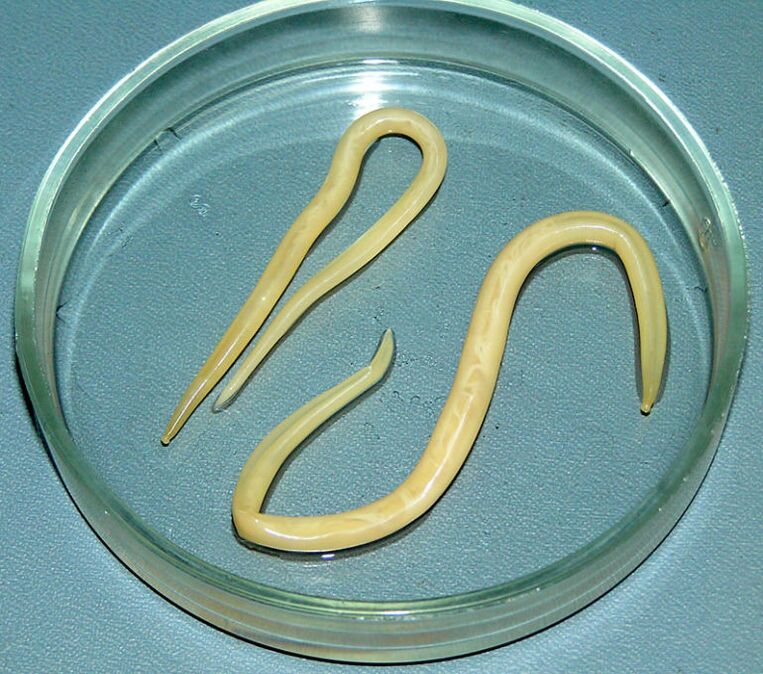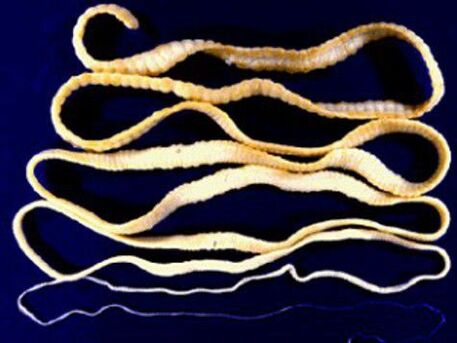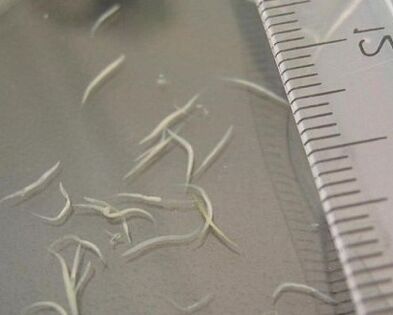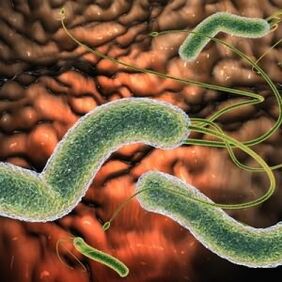Studies in the field of parasitic medicine are reported by alarming facts. More than 90% of all age categories are affected by the helm tentn or have a hidden form of transportation of various parasites. They cause many problems, causing various diseases that prevent a person's normal life. Choosing the Habitat - the human body, parasites can virtually spread to all organs and systems, causing pathological changes in them and violating the function of their work.

The main types of parasites in the human body
The group of parasites that made their human body habitat include the simplest microorganisms, round worms and ribbons:
- High. They are small parasites (long, no more than one cm and a half), which are transmitted to home or in contact with an infected person. Often, flies that carry the larvae of these worms parasites are for those with this helm tentn invasion. Once in products, they have been there for a long time and, if not processed, enter the human body. Propagating in the human body, they cause enterobiasis. Most of the time, children of pre -school and school age are subject to this type of disease. Enterobiasis lesions in children and adult population can reach up to 90 %. The habitat of these parasites are the blind segments, the bowel of the intestine. This type of parasite does not breathe air; Oxygen is not necessary for its existence. The nutrients for this are the content of the intestine. After mating, which occurs in the ileum of the ileum, crawling out of the anus, the female lay the larvae in the sphincter area of the anus. The greatest danger that enterobiasis is highly contagious. Parasites are very easy to infect with the slightest deviation from individual hygiene standards.
- Askarids. Belong to the round worms class. Parasitized in the small intestine. Call Aschariasis. The source of infection is a sick or animal person. Infection occurs through food, not washed hands. Parasite worms cysts, falling into the ground, mature to the larvae level, are dangerous to humans. If a person has already used non -washed fruits or vegetables, the body is infected. This is also facilitated by unhealthy residence conditions, insufficient food treatment of food.
- Ankylostoma. They lead to the development of the pathological process in the body. This is a small parasite, which does not reach more than 2 cm in its length. Most of the time, young children are infected (especially in rural areas due to bare feet).

- Wide tape. It belongs to the group of worms of the strip, has 12 varieties. The main place of parasitization is the gut department. The main path of body infection occurs when fish (which did not pass sufficient heat treatment) or through objects that were used to cut meat (knives, cutting board). This type of parasite feeds on all the beneficial substances a person uses. Its length can reach 15 meters.
- Taurus and pork. These are tape worms, whose length is 10 meters. When infected with bull tape spores, tusiarinchose develops and, in the case of pork chain larvae, taeriasis disease develops, its larval stage is called cystiracosis. The development of such pathologies is usually facilitated by ingestion of meat and poorly processed meat. But sometimes the infection can occur through uninsy hands and food. As a rule, in the small intestine of the body, when infected with this disease, one lives in a worm. In some cases, the duration of its existence may last up to 20 years. As, with the help of its hooks, located on the parasite's head, it is strongly attached to the small intestine wall. And therefore, sometimes difficulties arose for their withdrawal.
- Echinococos. They are tape worms up to 8 mm in length, they can cause a disease called echinococcosis. The disease is often found in animals (cats, dogs, foxes, wolves). It should be noted that the human body, for equinochocic pathology, is a place of intermediate residence. The infection process occurs during direct contact with the animal or by cutting it. This type of disease is more affected by the rural population involved in animal breeding. The disease often occurs without symptoms and, in the case of manifestation, cystic formations occur. To remove them, it is necessary to use only the surgical method.
- Lamblia. Lead to the development of lambliosis. The parasites belong to the Zhgutikov class, are representatives of demolomonadids detachment. A favorite habitat is a small intestine of a person or animals. Sometimes they can affect the digestive bird system. Infection occurs in two ways: sometimes there is infection through the respiratory tract. The cysts enter the body through the lungs, along with the inhaled dust, the clinical picture in this pathology can be disguised as other diseases. And it is accompanied by the development of nervous, heart and endocrine diseases.
- Parasitic mushrooms. They are capable of causing different pathological conditions in the human body (actinomycosis, lichen, microposporia, tricophytosis, favus, erytrazm). They live in the human body, affecting the skin, the hair, the nail talk.
- Parasites of African malaria.This group includes evil plasmodian. They are able to cause malaria. This disease is transmitted only through mosquitoes. For our area, this disease is not characteristic. It is subject to people living in the southern countries. This infectious disease can develop when visiting these countries. One feature of this disease is that local residents have the opportunity to get much lower than tourists. This is due to the fact that they develop immunity.

The infection is based in many basic ways:
- Fecal-oral. The use of uninsy vegetables and fruits, not cooked water.
- Percous. With this type of infection, the helm tentn invasion fall through the pores of the skin.
- Contact daily items or in contact with infected ones.
One feature of all forms of helm -parasites is that they eat at the expense of their owner (person or animal), while he selects useful nutritional ingredients (glucose, micro and useful macroelements, carbohydrates). As a result of a pathological effect, the body begins to experience acute foul from potassium, magnesium, zinc, silicon, selenium and many vitamins. Another feature of these parasites is a high degree of adaptation. They adapt to the working conditions of the owner's body. And they are made invisible to the immune system.
The causes of infection with the parasites of the human body
Among the forms of infection, the following can be distinguished:

- Eggs and parasites larvae penetrate the body when using dirty and semi water. Or when eating food (fish, meat, canned foods), which did not receive sufficient heat treatment. This is also facilitated by eating uninsy vegetables and fruits.
- Helminth eggs and cysts remain on the surface of the skin with direct contact with daily objects (doorknobs, money, toys, stairs). In addition, the source of infection may be contained in the soil, when contacting the soil, parasites spores fall into the hands. And if they are not completely washed, it also creates a risk of threat of body infection with various types of helmets. Therefore, the hands should be washed not only before eating, but also several times during the day, especially if there is contact with the ground.
- Several insects (flies, wasps, fleas) create a real threat of worms infection. For this, the insect does not need to make a bite. It is enough that they sometimes penetrate freely in the dwelling and sit in food, cutlery, leaving them spores in the larvae of the parasites worms.
If everyday work consists of direct contact with animals (veterinary, rural resident, cattle), the probability of the disease increases significantly.
The main signs and symptoms of parasites in the body
A very important role in the appearance of the first basic signs and symptoms with the development of helmintic invasions is occupied by their location and skills in the human body. Most of the time, they settle in the upper parts of the small intestine (wide ribbon, bulls and pork chain, ascarides).

Vlasov, by their habitat, chooses the large intestine segment. Opistochosis affects the biliary tract of the ducts. Pinworms are located in the lumen of the colon and rectum. Serious dangerous diseases may appear:
- Pain during urination.
- Adenomatous growths.
- An irregular and painful menstrual cycle.
- The appearance of hepatitis and dermatitis.
It is very important to pay attention to the symptoms above. Despite the fact that at first glance they seem harmless, in fact, these signs may indicate the presence of parasites in the body.
Symptoms that appear when parasitizing the body are often perceived by patients such as the presence of any other disease that is not associated with the appearance of worms. This is a great difficulty in making a precise diagnosis. The main symptoms in the development of parasitic worms in humans:
- Violation of the act of defecation (constipation). It appears due to the fact that the accumulation of worms makes it difficult to pass the stool in the intestinal lumen.
- Sometimes diarrhea is observed. This is due to the enhanced production of ferminas (a substance of the hormone type, produced in the body of parasites) and leads to an imbalance of chloride ions. Which explains the cause of diarrhea.
- Increased gas formation.
- There is a violation of lanoline processing and assimilation (fat). This is due to the fact that, by parasite in the lumen of the small intestine, parasites cause inflammatory diseases of the intestinal mucosa.
- Arthralgia and muscle pain occur.
- In response to the body, manifestations of allergies arise, sometimes in the form of hives.
- Perhaps the development of ulcer eczema, skin dermatitis, the appearance of tumors.
- In the case of the development of helminthiasis, which feeds on blood elements, iron deficiency anemia is possible.
- With a clinical blood test, a small amount of red blood cells, a small level of hemoglobin and a decrease in the color indicator are observed.
- Often, abdominal or uterine cavity granulomas, lungs and liver.
- The patient's psycho -emotional state is impaired, which is expressed by irrational aggressive conditions, greater excitability.
- Due to severe anus itching, night sleep is disturbed.
- At night, the patient has a rattle of teeth (bruxism).
- The lack of hill, vitamins, amino acids, proteins and carbohydrates leads to the development of chronic fatigue, a breakdown of strength.
- The constant feeling of hunger, the development of symptoms of anorexia.
- Cardiac muscle disease, failure in heart rate.
- In severe cases, the development of oncopathology.

Not only the type of parasite that has been established in the human body, but also in its age, gender, physical characteristics of the body, has a significant impact on the clinical picture.
With the development of the acute stage of damage by helm tentn invasions, the patient has all the signs of acute poisoning throughout the body:

- Nausea, becoming indomitable vomiting.
- Hyperthermia (sometimes for high numbers 38, 9).
- Another's skin rashes.
- Regional lymph nodes are inflamed.
- Pathological processes in the liver and lungs are aggravated.
If such symptoms appear, the visit to the doctor is vital
Diagnosis of parasites in the human body
For a precise diagnosis, you should consult a parasitologist. But often in the city's clinics there is no standard unit. Therefore, you should contact a therapist or gastroenterologist for subsequent tests and an additional consultation from an infectious diseases parasitologist. For a long time, the determination of parasites infection was performed only by performing fecal tests for the presence of worm eggs or duodenal sounds. A fence of the intestine content material was performed.
Presenting a probe. Such research methods do not always reveal the presence of worms in the human body. Modern diagnostic methods (ELISA tests) allow you to detect and determine any form of parasitic worms in the human body. They are based on the identification of antibodies that the body produces in response to the poisoning caused by the helm tinty invasion. In addition, serological techniques were used:
- REEF.
- Ral.
- Rsk.

As an additional research method, it is used:
- Endoscopic examination.
- Ultrasound.
- Magnetic resonance imaging.
- Endobiopsy.
- Establishing a precise diagnosis using PCR.
Relatively recently, a system symptomometer appeared. It is capable of detecting endotoxins, microbial flora and tumor cells using an expanded electromagnetic range. With the help of frequency resonance therapy, you may not only diagnose, but also effective therapy in any form of helminths, regardless of where they live.






































